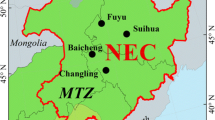Abstract
Soil temperature is an important factor within the climate system. Changes of trends in soil temperature and analysis of vulnerability due to heat stress can provide useful information on climate change. In this paper, the soil temperature regime was analyzed on seasonal and annual scales at depths of 2, 5, 10, 20, 30, and 50 cm at 26 sites in Croatia. Trends of maximal, mean, and minimal soil temperatures were analyzed in the periods 1961–2010 and 1981–2010. Duration of extreme soil temperatures and vulnerability due to high or low soil temperatures in the recent standard period 1981–2010 was compared with the reference climate period 1961–1990. The results show a general warming in all seasons and depths for maximal and mean temperatures in both observed periods, while only at some locations for minimal soil temperature. Warming is more pronounced in the eastern and coastal parts of Croatia in the surface layers, especially in the spring and summer season in the second period. Significant trends of maximal, minimal, and mean soil temperature in both observed periods range from 2.3 to 6.6 °C/decade, from −1.0 to 1.3 °C/decade, and from 0.1 to 2.5 °C/decade, respectively. The highest vulnerability due to heat stress at 35 °C is noted in the upper soil layers of the coastal area in both observed periods. The mountainous and northwestern parts of Croatia at surface soil layers are the most vulnerable due to low soil temperature below 0 °C. Vulnerability due to high or low soil temperature decreases with depth.








Similar content being viewed by others
References
Curiel Yuste J, Baldochhi DD, Gershenson A, Goldstein A, Misson L, Wong S (2007) Microbial soil respiration and its dependency on carbon inputs, soil temperature and moisture. Glob Chang Biol 13:2018–2035. doi:10.1111/j.1365-2486.2007.01415.x
Derežić D, Vučetić V (2011) The rising tendency of mean soil temperature in Croatia (in Croatian). Croat Meteorol J 47:85–96
Eliasson Å, Terres J-M, Bamps C (2007) Common biophysical criteria for defining areas which are less favourable for agriculture in Europe. Proceedings and JRC Scientific and Technical Reports from the Expert Meeting 19–20 April 2007. Ispra, Italy pp 47–81
Feist O (2011) Analysis of heat stress for the agricultural purposes in Croatia in the past, present and future climate conditions (in Croatian). Diploma thesis, University of Zagreb
Garcia-Suarez AM, Buttler CJ (2006) Soil temperatures at Armagh Observatory, northern Ireland from 1904 to 2002. Int J Climatol 26:1075–1089. doi:10.1002/jic.1294
Gilbert RO (1987) Statistical methods for environmental pollution monitoring. Wiley, New York
Gocic M, Trajkovic S (2013) Analysis of changes in meteorological variables using Mann-Kendall and Sen’s slope estimator statistical tests in Serbia. Glob Planet Chang 100:172–182
Hall AE (2001) Consideration of crop response to environment in plant breeding. In: Crop response to environment. CRC Press LLC, Boca Raton, pp. 197–208
Kaučić D (1989) Soil temperature characteristics in Croatia (in Croatian). Croat Meteorol J24:65–71
Kaučić D (2001) Anomalies of soil temperatures in Croatia from March to August 2000 (in Croatian). J For Soc Croat 5–6:291–297
Mitchell JM Jr, Dzerdzeevskii B, Flohn H, Hofmeyr WL, Lamb HH, Rao KH, Wallen CC (1966) Climatic change. WMO Technical Note No. 79, Geneva, pp 58–75
MZOIP (2014) Sixth National Communication and First Biennial Report of the Republic of Croatia under the United Nation Framework Convention on the Climate Change. Republic of Croatia Ministry of Environmental and Nature Protection (MZOIP), Zagreb, pp 247 http://unfccc.int/files/national_reports/annex_i_natcom_/application/pdf/hrv_nc6.pdf
Otorepec S (1980) Agrometeorology. Nolit, Beograd
Penzar I (1978) Soil temperature (in Croatian). Contributions to the knowledge of weather and climate of Yugoslavia, 4, Federal Hydrological Institute, pp 65–95
Porter JR, Gawith M (1999) Temperatures and the growth and development of wheat: a review. Eur J Agron 10(1):23–36. doi:10.1016/S1161-0301(98)00047-1
Porter JR, Semenov M (2005) Crop responses to climatic variation. Philos Trans R Soc B 360(1463):2021–2035. doi:10.1098/rstb.2005.1752
Qian B, Gregorich EG, Gameda S, Hopkins DW, Wang XL (2011) Observed soil temperature trends associated with climate change in Canada. J Geophys Res 116:D02106. doi:10.1029/2010JD015012
Ryden J (2011) Statistical analysis of temperature extremes in long-time series from Uppsala. Theor Appl Climatol 105:193–197. doi:10.1007/s00704-010-0389-1
Sayemuzzaman M, Jha MK, Mekonnen A (2014) Spatio-temporal long term (1950-2009) temperature trend analysis in North Carolina, United States. Theor Appl Climatol. doi:10.1007/s00704-014-1147-6
Van Orshoven J, Terres J-M, Tóth T (2008) Common bio-physical criteria to define natural constraints for agriculture in Europe. Definition and scientific justification for the common criteria. JRC Scientific and Technical Reports EUR 23412 EN 2008.
Vučetić V, Jakovčić P (2014) Soil temperature regime in Croatia. Proceedings of the conference on meteorology, climatology and atmospheric physics 28–31 May 2014, Heraklion, Greece, http://comecap2014.chemistry.uoc.gr/COMECAP-ISBN-978-960-524-430-9-vol.%203.pdf
Wheeler TR, Craufurd PQ, Ellis RH, Porter JR, Prasad VPV (2000) Temperature variability and the yield of annual crops. Agric Ecosyst Environ 82:159–167. doi:10.1016/S0167-8809(00)00224-3
Yeşilırmak E (2013) Soil temperature trends in Büyük Menderes Basin, Turkey. Meteorol Appl 21:859–866. doi:10.1002/met.1421
Zalar M, Črepinšek Z, Zupanc V, Kajfež-Bogataj L (2015) Analysis of soil temperature for chosen locations in Slovenia for 1980–2010 (in Slovenian). New challenges in agronomy 2015: proceedings of symposium 29–30 January 2015, Laško, Slovenia. ISBN 978-961-90884-8-7
Zaninović K, Gajić-Čapka M, Perčec Tadić M, Vučetić M, Milković J, Bajić A, Cindrić K, Cvitan L, Katušin Z, Kaučić D, Likso T, Lončar E, Lončar Ž, Mihajlović D, Pandžić, Patarčić M, Srnec L, Vučetić V (2008) Klimatski atlas Hrvatske/Climate atlas of Croatia 1961–1990, 1971–2000. Državni hidrometeorloški zavod/Meteorological and Hydrological Service, Zagreb, pp 50 http://klima.hr/razno_e.php?id = news¶m = atlas_e
Zhang T, Barry RG, Gilichynsky D, Bykkovts SS, Sorokovikov VA, Ye J (2001) An amplified signal of climatic change in soil temperatures during the last century at Irtutsk, Russia. Clim Chang 49:41–76
Acknowledgments
This research has been carried out as part of the project COST Action ES1106 “Assessment of EUROpean AGRIculture WATer use and trade under climate change” (EURO-AGRIWAT).
Author information
Authors and Affiliations
Corresponding author
Rights and permissions
About this article
Cite this article
Sviličić, P., Vučetić, V., Filić, S. et al. Soil temperature regime and vulnerability due to extreme soil temperatures in Croatia. Theor Appl Climatol 126, 247–263 (2016). https://doi.org/10.1007/s00704-015-1558-z
Received:
Accepted:
Published:
Issue Date:
DOI: https://doi.org/10.1007/s00704-015-1558-z




